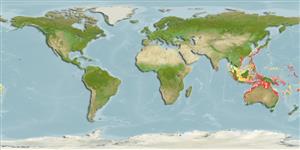Environment: milieu / climate zone / depth range / distribution range
पारिस्थितिकी
समुद्री; स्वच्छ जल, अलवण जल; खारा बेनथोपिलाजिक. Tropical
Western Central Pacific: Australia and New Guinea.
आकार / वज़न / Age
Maturity: Lm ? range ? - ? cm
Max length : 30.0 cm TL पुल्लिंग / अलिंग; (Ref. 34016)
Occur inshore, in mangrove areas; in lotic and lentic freshwater bodies (Ref. 7300). Live in coastal marine waters, but also found in estuaries and freshwater sections of rivers (particularly in temperate southern latitudes) (Ref. 44894). Benthic omnivore, juveniles feed on algae and a range of small crustaceans, while older fish prey mainly on polychaetes (Ref. 34016). Eggs are guarded and fanned by the male parent (Ref. 205).
Eggs are guarded and fanned by the male parent (Ref. 205).
Paxton, J.R., D.F. Hoese, G.R. Allen and J.E. Hanley, 1989. Pisces. Petromyzontidae to Carangidae. Zoological Catalogue of Australia, Vol. 7. Australian Government Publishing Service, Canberra, 665 p. (Ref. 7300)
IUCN Red List Status (Ref. 130435)
Threat to humans
Harmless
Human uses
अधिक जानकारी
संदर्भजलीयकृषिजलीयकृषि रूपरेखाखींचआनुवंशिकीElectrophoresesहैरेटिबिलटीबीमारीप्रक्रमणNutrientsMass conversion
सहयोगीयोतस्वीरेStamps, Coins Misc.ध्वनिसिगुयटिरारफ्तारतैरने के प्रकारगिल क्षेत्रOtolithsदिमागदृष्टि
साधन
Special reports
Download XML
इंटरनेट स्रोत
Estimates based on models
Preferred temperature (Ref.
123201): 23.8 - 28.8, mean 27.6 °C (based on 416 cells).
Phylogenetic diversity index (Ref.
82804): PD
50 = 0.6250 [Uniqueness, from 0.5 = low to 2.0 = high].
Bayesian length-weight: a=0.01288 (0.00598 - 0.02775), b=3.05 (2.86 - 3.24), in cm total length, based on LWR estimates for this (Sub)family-body shape (Ref.
93245).
Trophic level (Ref.
69278): 3.2 ±0.1 se; based on diet studies.
Generation time: 2.7 ( na - na) years. Estimated as median ln(3)/K based on 1
growth studies.
लौटाव (Ref.
120179): माध्यम, न्यूनतम जनसंख्या दुगनी होने का समय 1.4 - 4.4 वर्ष। (K=0.06-0.41).
Fishing Vulnerability (Ref.
59153): Low to moderate vulnerability (29 of 100).
